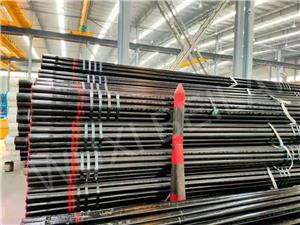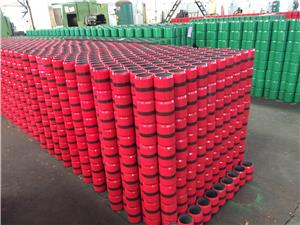What types of fins are there in finned tubes?
Fin tubes are high-efficiency heat exchange elements that increase heat transfer efficiency by adding fins to the outer surface of the tube. Fins come in a variety of designs and types, and each type has its own unique structural characteristics and application scenarios. This article will introduce several common fin types in detail and analyze their advantages and scope of application.
1. Straight fin
Structural features: Straight fins are arranged along the axis of the tube and perpendicular to the outer surface of the tube.
Advantages: Straight fins have simple structure and low manufacturing cost, and are suitable for general heat exchange needs.
Application: Straight fins are widely used in common heat exchange equipment such as air conditioners, condensers, and evaporators. These devices typically do not require very high heat transfer efficiencies, so the simple design and ease of fabrication of straight fins make them an economical and practical option.
2. Spiral fins
Structural features: The spiral fins are arranged spirally along the tube to form a spiral structure.
Advantages: Spiral fins can increase the turbulence of the fluid, thereby improving heat transfer efficiency. This design helps reduce thermal resistance and improve heat transfer performance.
Application: Spiral fins are often used in industrial boilers, water heaters and other equipment that require efficient heat exchange. These application scenarios usually require efficient heat transfer to achieve rapid heating or cooling effects.
3. Corrugated fins
Structural features: The surface of the corrugated fin is wavy, which increases the heat transfer surface area.
Advantages: Corrugated fins can increase fluid disturbance, improve heat transfer efficiency, and reduce fluid resistance. This design effectively improves heat transfer performance.
Application: Corrugated fins are suitable for air conditioning, refrigeration equipment and some special industrial heat exchangers. These devices require efficient heat exchange performance and control of fluid resistance to ensure system operating efficiency.
4. Needle fins
Structural features: Needle fins are needle-shaped and extend vertically outward from the surface of the tube.
Advantages: Pin-shaped fins can significantly increase the surface area and improve heat transfer efficiency, and are especially suitable for high heat flow density applications.
Application: Pin-shaped fins are mostly used in electronic equipment radiators, aerospace and other fields that require efficient heat dissipation. These applications require efficient thermal management within a limited space.
5. Inlaid fins
Structural features: The inlaid fins are fixed on the surface of the tube through the inlay process and can be in various shapes such as spiral, straight fins, etc.
Advantages: The inlaid fins are firmly bonded, suitable for high temperature and high pressure environments, and have stable heat transfer performance.
Application: Inlaid fins are mainly used in heat exchange equipment in high temperature and high pressure environments such as petrochemical industry and natural gas processing. These devices require the fins to be firmly bonded to the tube wall to ensure long-term stable operation.
6. Galvanized fins
Structural features: The surface of the galvanized fins is galvanized to improve corrosion resistance.
Advantages: Galvanized fins have strong corrosion resistance, are suitable for harsh environments, and extend the service life of the equipment.
Application: Galvanized fins are widely used in highly corrosive environments such as marine engineering and chemical plants. These environments require finned tubes to have good corrosion resistance to ensure the stable operation and service life of the equipment.
7. L-shaped fins
Structural features: L-shaped fins are arranged spirally along the tube, and the cross-section of the fins is L-shaped.
Advantages: L-shaped fins increase the heat transfer surface area, the contact area between the fins and the tube wall is large, and the heat transfer performance is good.
Application: L-shaped fins are suitable for various occasions that require efficient heat transfer, such as industrial heat exchangers, heaters, etc. These devices require efficient heat transfer performance to increase the overall efficiency of the system.
8. U-shaped fins
Structural features: U-shaped fins have a U-shaped cross-section and are usually double or multiple structures.
Advantages: U-shaped fins have stable structure, good heat transfer performance, and are suitable for high temperature environments.
Application: U-shaped fins are commonly used in high-temperature industrial equipment, boilers, etc. These devices operate at high temperatures and require the finned tubes to have excellent heat transfer performance and structural stability.
9. G-type fins
Structural features: G-shaped fins are tightly integrated with the tube wall through mechanical processing, and the fin cross-section is G-shaped.
Advantages: G-shaped fins are firmly combined with the tube wall, have excellent heat transfer performance and good vibration resistance.
Application: G-type fins are suitable for industrial equipment requiring high strength and efficient heat transfer. These devices need to work under harsh conditions, so the finned tubes are required to have high strength and good vibration resistance.
10. Annular fins
Structural features: The annular fins are arranged around the radial direction of the tube to form an annular structure.
Advantages: The annular fin has a uniform structure and good heat transfer performance, and is suitable for gas heat exchange outside the tube.
Application: Annular fins are mostly used in air conditioners, refrigeration equipment and some industrial heat exchangers. These devices require efficient gas heat exchange performance to improve the overall efficiency of the system.




